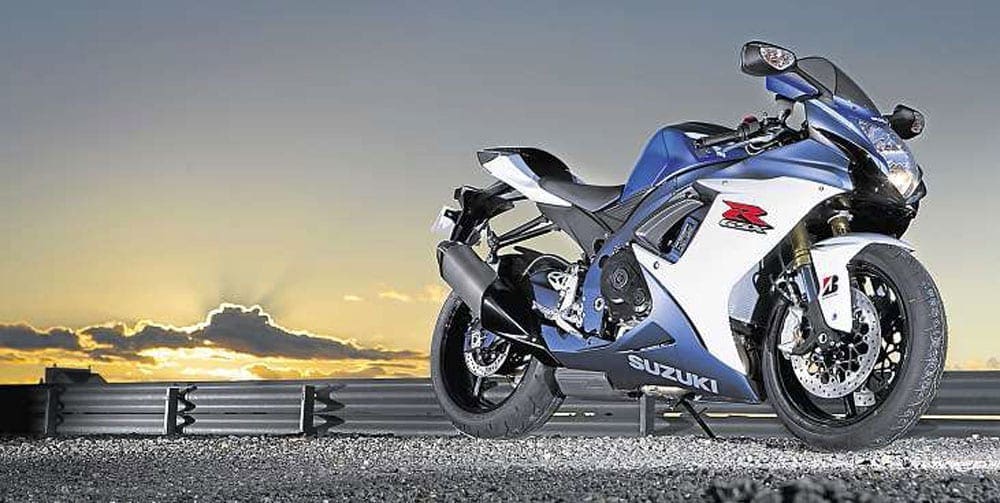Just four bends into my third session aboard this latest version of Suzuki’s legendary three quarter- litre rocketship, and already my spirits are soaring and my doubts have been blown away.
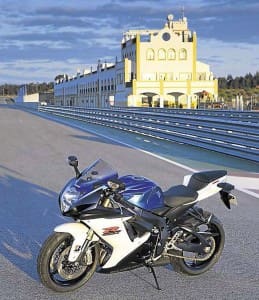 The GSX-R750 L1’s tyres aren’t even back up to full temperature, yet the bike has just sliced through the Spanish Monteblanco circuit’s second-gear chicane with the sharpness and precision I’d expected, but which were surprisingly lacking in the earlier two morning sessions.
The GSX-R750 L1’s tyres aren’t even back up to full temperature, yet the bike has just sliced through the Spanish Monteblanco circuit’s second-gear chicane with the sharpness and precision I’d expected, but which were surprisingly lacking in the earlier two morning sessions.
All of a sudden, the GSX-R’s revamped chassis and reduced weightmade sense, as a bike that felt strangely reluctant to turn into bends has now been transformed by a couple of turns of the Showa Big Piston Forks’ damper screws. By the time I’d despatched the Spanish track’s remaining turns to complete the lap, it was clear that this latest bike in the GSX-R750 line is every bit as agile—and as quick—as the spec sheet says it should be.
This comprehensively revamped GSX-R certainly looks good on paper, even if it doesn’t quite have the styling to match. The lines of this bike and the new GSX-R600, which is visually identical apart from graphics, are neat enough, and no doubt the shape is aerodynamically efficient too, with its stacked dual headlights and front indicators set into the mirrors. But the 750 would hardly stand out in a row of older models, and it’s a shame that Suzuki has yet again missed the opportunity to give the Gixxer a more radical look.
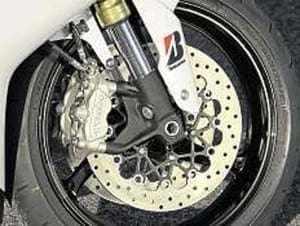 Can’t fault the engineers for effort, though–especially on the weight loss programme. There are plenty of technical advances even before you look under the skin, because that bodywork is not merely different in shape. The fairing has fewer sections, with reduced overlap between them, and is also thinner (and it feels thin, too).
Can’t fault the engineers for effort, though–especially on the weight loss programme. There are plenty of technical advances even before you look under the skin, because that bodywork is not merely different in shape. The fairing has fewer sections, with reduced overlap between them, and is also thinner (and it feels thin, too).
Those changes explain how the fairing can weigh 3.4kg less than the previous model’s, contributing almost half of the total weight loss of 8kg. That’s an impressive figure given the previous GSX-R750’s supermodel skinniness. So too is the claimed overall kerb weight of 190kg, which equates to a remarkable dry figure of just 159kg (last year’s L0 weighed 167kg dry).

The next biggest chunk of weight saving comes from the new frame, which is 1.3kg lighter and also tips the engine back by 3º, allowing the front wheel to be pulled back and the wheelbase to be reduced by 15mm. Revisions to the swingarm design save almost another kilo (if this stuff sounds familiar, that’s because the recently launched GSX-R600’s frame and swingarm as ridden in last month’s MCM, are identical).
 The biggest chassis change is at the front end, where the 750 matches the smaller model in sporting a pair of Showa Big Piston Forks, along with Brembo four-piston monobloc calipers — the first time the Japanese firm has used the Italian brakes. The forks and calipers save a further 1kg and 0.4kg respectively.
The biggest chassis change is at the front end, where the 750 matches the smaller model in sporting a pair of Showa Big Piston Forks, along with Brembo four-piston monobloc calipers — the first time the Japanese firm has used the Italian brakes. The forks and calipers save a further 1kg and 0.4kg respectively.
There are fewer changes to the 750cc 16-valve engine, which gets some but not all of the smaller GSX-R’s top-end changes. New piston pins save a few grams, larger crankcase ventilation holes reduce pumping losses, and numerous parts have been redesigned to save weight—a total of 2kg in the engine.
Breathing is also tweaked, with a revised injection system whose primary throttle valve is set at amore acute angle, optimising the direction of the fuel spray. Suzuki claim this engine is 10% more fuel efficient than the old one, also helped by a more sophisticated ECU. Its max power output of 150bhp at 13,200rpm is unchanged but there’s a slight torque increase in the midrange.
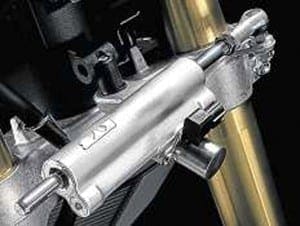 The motor certainly sounded sharp in the Monteblanco pit lane, rasping through its airbox and smaller, lighter new silencer. The Suzuki also had a throaty bark as it grunted out of slow turns on the track. But initially I was disappointed that the model’s famed balance between big-bike power and middleweight agility simply wasn’t there.
The motor certainly sounded sharp in the Monteblanco pit lane, rasping through its airbox and smaller, lighter new silencer. The Suzuki also had a throaty bark as it grunted out of slow turns on the track. But initially I was disappointed that the model’s famed balance between big-bike power and middleweight agility simply wasn’t there.
That wasn’t the fault of the engine, which performed just as advertised: revving rapidly and sweetly towards its 14,250rpm redline through the gears, and charging out of turns with more enthusiasmt han any 600 could manage, if inevitably without approaching the GSX-R1000’s grunt. It despatched the long pit straight at a hell of a rate, putting 160mph on the digital speedo with more to come. The motor stayed smooth even at five-digit revs, too, with nicely crisp throttle response.

I’ve no reason to doubt Suzuki’s claim that there’s a slight increase in midrange delivery, which will be welcome on the road but was impossible to detect at Monteblanco, even on a fifth-gear lap that confirmed the GSX-R pulled cleanly, if not particularly strongly, from below 6000rpm. For track use it needed at least 10,000rpm on the black-finished analogue tacho, which was unnecessarily difficult to read.
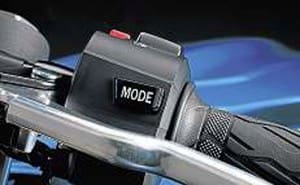 At least I could change gear with the benefit of the instrument console’s contrastingly bright and useful new line of four programmable shift lights. Other instruments and controls were fine, too, including the now bar-mounted button to toggle the speedo’s functions. Some riders might even find a use for the engine’s low-power setting, now operated from the left bar and giving a 100bhp max with softer delivery.
At least I could change gear with the benefit of the instrument console’s contrastingly bright and useful new line of four programmable shift lights. Other instruments and controls were fine, too, including the now bar-mounted button to toggle the speedo’s functions. Some riders might even find a use for the engine’s low-power setting, now operated from the left bar and giving a 100bhp max with softer delivery.
Other civilising touches include the slightly less stretched-out riding position, due to clip-ons set slightly further back. Revised footrests are lighter than their predecessors but still offer a choice of three positions, the lowest of which cramped my long legs notably less than the others. By contrast the pillion seat is even smaller than before, though fortunately I wasn’t forced to try that out.
Much to m surprise, theGSX-R’s extra rider-friendliness didn’t extend to its chassis performance, at least at first. Instead the bike felt less flickable and precise than I’d expected. It resisted being pulled down into a turn, the front end twitched as I released the front brake approaching the apex, and the bike needed effort to stop it running slightly wide.
Those much-hyped BPF forks were to blame, or at least their setting was. The bikes had been set up with a bit of extra compression and rebound damping up front, compared to standard showroom settings, and with the rear end raised slightly by a 4mm spacer inside the shock’s top mount. Presumably that worked for Suzuki’s test riders but it didn’t for me.
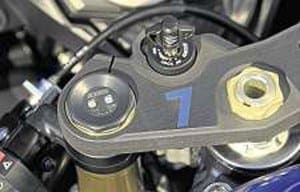 Fortunately, the cure was just seconds away. Removing half a turn of compression damping, and adding a similar amount of rebound – both via the screws conveniently accessible on the fork tops — transformed the bike. Now the front end dipped enough to quicken the steering into turns, and also remained stable as I let off the brake. Immediately I was hitting apexes, braking later… and lapping with a typical GSX-R pilot’s manic grin behind my visor.
Fortunately, the cure was just seconds away. Removing half a turn of compression damping, and adding a similar amount of rebound – both via the screws conveniently accessible on the fork tops — transformed the bike. Now the front end dipped enough to quicken the steering into turns, and also remained stable as I let off the brake. Immediately I was hitting apexes, braking later… and lapping with a typical GSX-R pilot’s manic grin behind my visor.
It was good to have such suspension quality at both ends, although the launch bikes could have used rubber to suit. Instead we were on BridgestoneBT- 016 Pros, the standard replacement for the bike’s original equipment BT-016s. Despite their name the Pros are not track tyres but are heavier than the standard fitment BT-016 G spec rubber, designed to give better mileage and wet weather performance. They’re good tyres but stickier rubber would have been better suited to the slick Spanish circuit.
Even so, charging round Monteblanco was brilliant fun once the chassis was sorted. The Suzuki twitched its bars a few times but always regained control rapidly, with the help of the electronically controlled steering damper. For such a short, light bike it was brilliantly stable. Once properly set up itwas certainly quick and fast enough to suggest it has a small but worthwhile edge over last year’s model.
As for Suzuki’s familiar claim that the GSX-R750 provides the power of an open-class superbike with the agility of a middleweight? Well, it has more power than the 600, its chassis is almost identical and in many respects it is a very good compromise. At £9899 its price is roughly midway between those of the other two models, and of the three (600, 750 or 1000) it’s the one I’d buy.
Words: Roland Brown Pics: Wout Meppelink & Tom Haanstra
TECH SPEC
Price: £9899 plus OTR (£125 approx)
Engine: 750cc, liquid-cooled, DOHC, six-speed, fuel-injected transverse four with four valves per cylinder
Max power (claimed): 150bhp@13,200rpm
Max torque (claimed): 63.43lb-ft@11,200rpm
Bore x stroke: 70 x 48.7mm
Rake and Trail: 23.45º x 97mm
Chassis: Aluminium beam
Suspension: Front:41mm Showa PBF upsidedown telescopic,120mm travel, adjustments for preload, compression and rebound damping. Rear: Showa shock,130mm wheel travel, adjustments for preload, high- and low-speed compression, and rebound damping
Brakes: Front: 2x four-piston Brembo Monobloc radial calipers,310mm discs. Rear: single-piston Nissin caliper,220mm disc
Wheels/tyres: Front: 120/70 x 17in Bridgestone Battlax BT-016 on cast aluminium rim. Rear: 180/55 x 17in Bridgestone Battlax BT-016 on cast aluminium rim
Wheelbase: 1385mm
seat height: 810mm
Kerb weight (claimed): 190kg
Fuel capacity: 17 litres
Colours: Blue/white, black
www.suzuki-gb.co.uk


